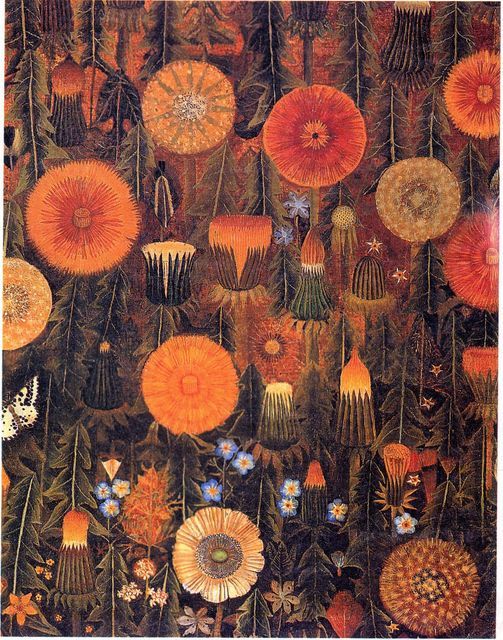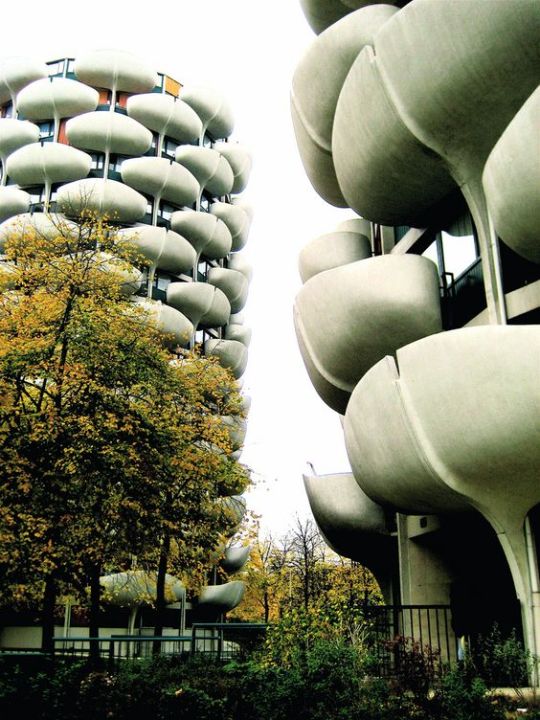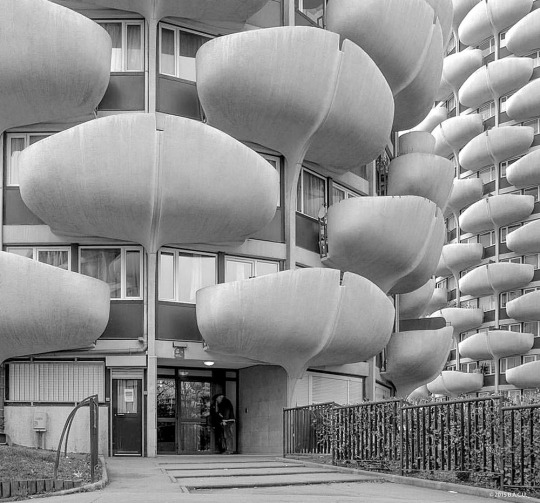#grandval
Explore tagged Tumblr posts
Text

sophie grandval -- dandelions
10 notes
·
View notes
Text

Les Choux
Créteil
Architect: Gérard Grandval
3 notes
·
View notes
Text

"Dandelions" (1990) by French artist, SOPHIE GRANDVAL, (b.1936).
Sophie Grandval started her career as a textile designer, working for names such as Givenchy, Dior, Balanciaga, Balmain, and Deusse.
In 1958 she exhibited at the Galerie des Beaux Arts in Paris fabric designs.
She started painting in oil and watercolour, and in 1961 had her first one-woman exhibition at the Galerie Durand, followed by another one ten years later at the Galerie Delpire, both in Paris. At both shows, all paintings were completely sold out during the preview evening.
An account of her told by renowned art dealer, Oliver Hoare:
"I first met Sophie Grandval in Paris in the mid-1960s, when I was a student and she was already a legend. Her first exhibition had caused a sensation, and every painting sold on the opening night. They have a powerful, naïve magic about them that seems to enchant all who look at them. She worked mainly in oils, but when Rachel 'Bunny' Mellon, the American horticulturalist, gardener, philanthropist, and art collector commissioned her to paint all the vegetables and plants in the King’s Vegetable Garden at Versailles in the early 1970s, she turned to watercolour.
In 1973 she moved to Bath. Her rooms there were extraordinarily atmospheric, festooned with dried flowers, strange gee-gaws, illustrations from magazines and books, and perfumed with the pungent aroma of hashish. On one visit she informed me that the previous evening she had been drinking in a pub when she realized that the Devil was sitting on the bar-stool next to her. This news was so surprising that I missed the opportunity to ask her what he was drinking."
Her work is to be found in prestigious collections such as those of Mrs Mellon, Givenchy, Dior, Cacharel, President Mitterand, and King Charles.
2 notes
·
View notes
Text

Portrait of the Actor Grandval
Artist: Nicolas Lancret (French, 1689–1743
Date: circa 1752
Medium: Oil on Canvas
Collection: Indianapolis Museum of Art, Indianapolis, Indiana
Description
Lancret's interest in the stage, evident in his insightful portraits of actors and dancers, may derive from his early training in the studio of Claude Gillot, director of scene designs and costumes for the Paris Opera. In this portrait of the actor Grandval, one of the best known performers of 18th-century Paris, Lancret alludes to his renowned ability to perform both tragic and comic roles. Grandval stands in an imaginary garden in front of a statuary group that represents Thalia, the Muse of Comedy, and Melpomene, the Muse of Tragedy.
#portrait#actor grandval#garden#muses#flowers#classic pillar#costume#nicolas lancret#french painter#18th century france#european art#standing#full length
0 notes
Text

Les Choux de Creteil by Gerard Grandval
402 notes
·
View notes
Text


Les Choux de Créteil, dix bâtiments cylindriques avec des balcons en forme de choux, en banlieue parisienne. Achevés en 1974. Conçus par l'architecte Gérard Grandval. (Photo c. 1974). - source The Modernist Collection.
105 notes
·
View notes
Note
Since someone asked about Polytheist Religion in FE, the people of Jugdral originally worshiped a variety of god, like the sky god and highest god Yudu, also called Gran. This is never mentioned in game but both the continent of Judgral and the kingdom of Grandvalle are named after him. Mentioned in a game, however, is the Earth goddess Ethnia, which Leif mention once in the infamous chapter 22 of Thracia 776.
Considering that both Yudu are based Ethnia on the figure of the Sky father and Earth mother common in indo-european patheons, once could easily speculate that this pantheon of Judgral also likely feature other common god of indo-european pantheons, like the pair of twin associated with the Sun and Moon.
However, once Gair travelled to Archanea and made a blood pact with Loptous, the empire he (well Loptous possessing him through the book) founded started worshiping Loptous and the human emperor serving as it's host. In fact, most of population of the empire still being "pagan" was used as a justification for their brutal treatment. Their was even an attempt to syncretism the two religion by Saint Maera, a member of the imperial familly, by placing Loptous as the supreme god of the Jugdral. The religious order that spawned from him would later save the twelve crusaders. From said crusader, Bragi, himself a priest of Maera order after they rescued him as child, would launch the church of Bragg(his hometown) which is the religion of Jugdral in FE4 and FE5 (just not officially during the new Empire period). This church still worship the old pantheon of Jugdral, but in addition also worship the deified Crusaders and the dragon Gods that give them their power. Considering how the old god are basically never cited, it also probable that said Crusaders and dragon Gods are much more popular figure of worship, considering the recency of the event (less than a century at the start of FE4) and the fact that said crusader created the moderns jugdral states.
So yes, there is actually a FE setting (a part of a setting to be exact) that is polytheistic. And yes this is just an excuse to lore dump on Jugdral.
Maybe this will get expanded in the remake, or maybe it will get dropped considering most of the source for this is one page on the old IS website : here the link (in japanese) if your interested http://web.archive.org/web/20000511184428/www.intsys.co.jp/game/fireemblem/note/2.html
.
16 notes
·
View notes
Text

Les Choux de Créteil Paris, designed by Gerard Grandval
2 notes
·
View notes
Text
youtube
Camille Saint-Saëns (1835-1921) - Four Orchestral Songs
1. Rêverie (1851) (0:00) Poetry: Victor Hugo (1802-1885)
2. Extase (c. 1860) (2:52) Poetry: Victor Hugo Dedication: à Madame Marie Delessert
3. L'attente (c. 1855) (6:48) Poetry: Victor Hugo Dedication: à Mademoiselle Marie Reiset (Clémence de Grandval)
4. Angélus (1918) (8:34) Poetry: Pierre Aguétant (1890-1940) Dedication: à Monsieur Plamondon
Yann Beuron, tenor (#2) Tassis Christoyannis, baritone (#1, 3 and 4) and Orchestra della Svizzera Italiana conducted by Markus Poschner
2 notes
·
View notes
Photo






Sophie Grandval (b 1936), after completing her art training, started her career as a textile designer, working for such famous names as Givenchy, Dior, Balanciaga, Balmain and Deusse.
In 1958, she exhibited at the Galerie des Beaux Arts in Paris fabric designs. At the suggestion of Lucien Durand, she started painting in oil and watercolour, and in 1961 had her first one-man exhibition at the Galerie Durand, followed by another one ten years later at the Galerie Delpire, both in Paris. At both shows, all paintings were completely sold-out during the preview evening.
She was then approached to do illustration work for Peter Knapp, the well-known art director for “ELLE” magazine, and in 1973 she moved to Bath to execute a series of botanical illustrations for the renowned American collector Mrs Paul Mellon.
https://www.chauchet.com/artists/sophie-grandval/
15 notes
·
View notes
Text
Visual Innovations in Carolingian Manuscripts
Carolingian manuscripts are among the earliest surviving examples of Western sequential art. These illuminations from the eighth and ninth centuries demonstrate unique storytelling solutions that speak to the ingenuity of their artists. Indeed, the monks at Tours and Reims did not simply copy their early Christian prototypes, but devised original works that would resemble the five principles of modern visual storytelling: timing (or implied action/encapsulation), “the frame” (or the organization of visual elements), imagery (typology), expressive anatomy (acting), and image-text interdependence (captions).
Take the Moutier-Grandval Bible, for example. Painted around the year 840, it contains four registers per page and depicts nine distinct scenes from the book of Genesis. The separated panels organize the visuals, drawing the eye from left to right and implying the passage of time. Likely inspired by Trajan’s Column, this technique was a novel application of the principles of timing and “the frame” to the page. While no text existed alongside the imagery, the artists of Tours provided summaries of the illustrations they preceded.
Some scriptoriums, however, were more confident in their visual storytelling abilities than others. The Reims school of illumination relied on the principle of imagery to communicate stories with symbolism that would have been well-known to the people of the time. Utrecht Psalter, a work dated somewhere between 816 and 835, did away with frames in favor of energetic compositions directly above, below, or even in-between corresponding passages. This resulted in manuscripts imbued with energy and agitation, essential qualities associated with expressive anatomy that is a cornerstone of the Reims style.
When examining the differences between the schools of Tours and Reims, it is important to remember they enjoyed access to similar source material. They are united by a common thread: their innovations in communicating a visual narrative. How they differed in execution is where creative ingenuity lies.
3 notes
·
View notes



